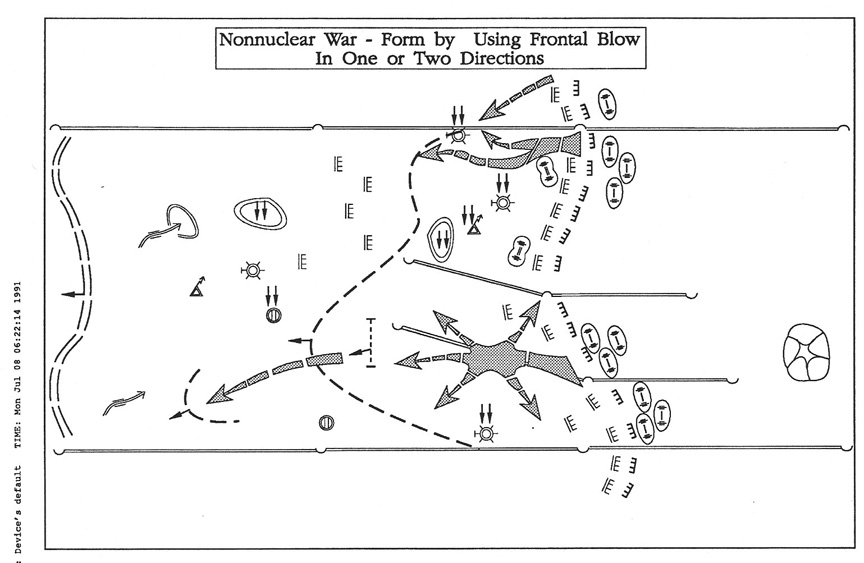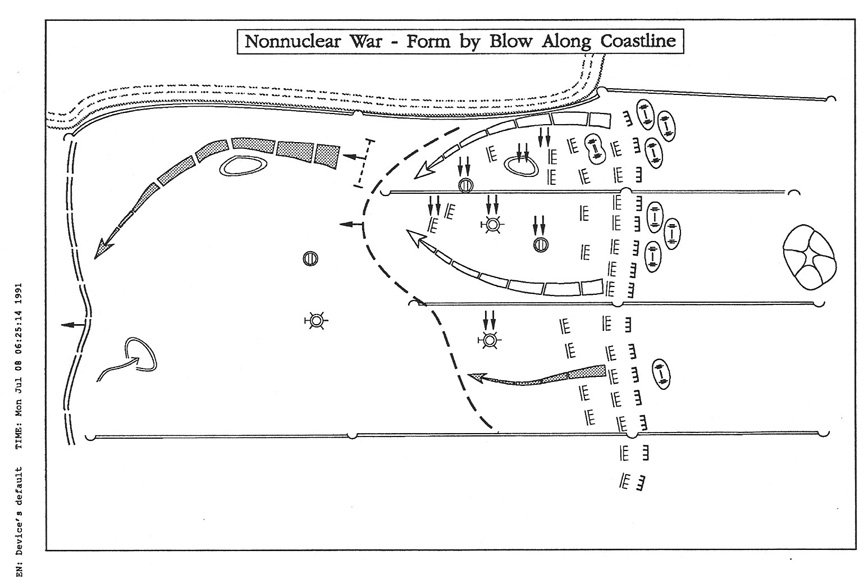| |
Exercise 1
In the initial instructions received by the front commander, the
front is assigned a mission for offensive operation with the
following:
Scope:
overall depth: 640 km
depth of immediate mission: 280 km
depth of long rang mission: 360 km
width of the front 340 km
duration of operations 14 days
The front is composed of four combined arms armies on D day, a tank
army will join the front on D + 2. During the clarification of the
mission determine the following:
----- number of attack directions and breakthrough areas;
----- number of armies in the first echelon;
----- rate of advance, and required correlation of forces for such rate of
advance.
Answer:
Since the direction of the main attack is determined by the superior commander,
the front is to facilitate the establishment of the appropriate
grouping of forces and means and support of the axis. However the
front will most likely have a choice to determine the number of
supporting attacks and forces allocated to them.
1. On the basis of initial data the front has one direction of main
attack. According to theory a major part of the forces should be allocated to
this direction: two armies with a frontage of not more than 60 km in a European
type of terrain (60 x 2=120 km of front). Now what is left is 340 - 120 + 220
km. Therefore this 220 km is to be covered by two more armies.
If the front launches a supporting attack with one army, it cannot
give the army a sector of more than 80 km.
-----(therefore: 220 - 80 + 140 km).
Now if one army is assigned this 140 km front, it cannot attack; but only will
hold the line or it may attack in a narrow sector merely to support the main
attack of the supporting attack directions like the following example:
|
|
| |
 |
|
| |
 |
|
| |
The alternative will be to have the forces in contact (if any) to hold
part of the front line in the front's sector in order to enable the
front to launch the attack by four armies with the following
variations.
These are preliminary deductions based on the clarification of the
mission. These variants can be further developed during the estimate of the
situation.
The determination of the number and overall width of the breakthrough areas
depends on the number of armies and divisions in the first echelon. This is
again a tentative and rough assessment, while the more detailed calculation can
be conducted later, on the basis of artillery capability and number and type of
enemy targets.
Penetration areas:
main direction: 2 armies each 12 km=24 km
supporting direction: 1 army 10 km - 10=total of 34 km
2. Rate of advance:
a. 640 ÷ 14=45 km/day
This is the average rate of daily advance which should be maintained. In order
to see if this rate of advance can be maintained, an overall and summary
correlation of forces and means is taken into consideration. A 3:1 correlation
supports an average rate of advance of 40 to 60 km/day.
b. To find out the required correlation of forces and means (basically on the
main direction) the formula/nomogram of ("Correlation of forces needed for
rates of advance") can be used:
f (factor)=D ÷ KTVmax;
f=correlation factor;
k=terrain factor (1.25 for open terrain);
Vmax=theoretical speed in km/day.
F=640 ÷ (1.25 x 14 x 70)=0.56
On the nomogram we read that a correlation of 4.6 to 1 is required to
achieve the accomplishment of the mission in 14 days. This is a rough
calculation and the enemy's detailed capabilities are not taken into
consideration. This correlation mostly applies to the axes of main attack,
while on axes with holding attacks a lower correlation can be accepted.
|
|
| |
Exercise 2:
On the basis of the clarification of the mission issue initial instructions to
the armies regarding the upcoming operations.
Answer:
See prepared text of the front's initial instructions to armies.
|
|
| |
Exercise 3:
Prepare the calculation of time available for the preparation of the operation
and develop the calendar plan of the preparation of the operation, when the
mission is received at 0800 June 10 and the time to be prepared for the attack
0500 June 14.
Answer:
(See the prepared calendar plan).
The calendar plan for the preparations of the operation is based on time
available generally speaking 1/3 of total time available to prepare for the
operations should be taken by front and 2/3 left for subordinates; 1/3
of the time taken by front includes:
----- making the decision;
----- conveying the decision to subordinates;
----- participation of subordinates in planning and coordination at the
front level.
|
|
| |
Exercise 4:
Given the location of the front forces and means determine the time to
mobilize and establish the grouping of forces and means in the departure area.
Answer:
Calculation of time is based on current data about the location of troops,
distance to the departure area and simple movement formulas for the following:
----- covering troops;
----- first echelon divisions of armies;
----- armies and front's support elements;
----- front's air army;
----- rear service installations;
|
|
| |
Exercise 5:
Assume that the four divisions attacking on the right flank and the three
divisions attacking in the army adjacent to it to the south are the main
direction.
On the supporting direction three divisions attack in the first-echelon with
one division of the adjacent army to the north participating in the
breakthrough. Determine the overall breakthrough area and number of artillery
pieces required.
Answer:
1. Main direction: 4 divisions + 3 divisions=7 divisions: the norm for the
width of the breakthrough area per division is 4 km. Therefore 7 x 4=28 km.
General norm for number of artillery pieces required per km of breakthrough
area is 100 (90-110). Therefore 28 x 100=2800 artillery pieces.
2. Supporting direction: 3 divisions + 1 division=4 divisions: 4 x 4=16 km
(width of breakthrough area): 16 x 100=1600 artillery pieces.
|
|
| |
Exercise 6:
Calculate the correlation of forces and means in the holding area when overall
correlation of forces and means is 3:1 and as discussed in exercise 1, the
width of the main sector is 120 km, of supporting attack sector 80 km, and
overall width of front's operation area is 340 km. The required
correlation of forces and means on the main direction as discussed in exercise
1 is 4.6 to 1 and in the supporting direction is 4 to 1.
Answer:
 Use
the following formula: Use
the following formula:

1. Main sector Vs the entire front:
120=340 (3 - Cs) ÷ (4.6 - Cs)
552 - 120 Cs=1020 - 340 Cs
220 Cs=468 ÷ 220
Cs=2
Therefore in the rest of the frontage (out of the main sector and overall
correlation of 2:1 is required.
2. Supporting sector Vs the rest of the front (340 - 120=220 km)
80=220 (2 - Cs) ÷ (4 - Cs)
320 - 80 Cs=440 - 220 Cs
140 Cs=120; Cs=120 ÷ 140=.85
Cs=.85
It means that if we establish a 4:1 correlation of forces and means in the
supporting attack sector, the overall correlation of forces and means in the
rest of the front (excluding the main and supporting attacking sectors) cannot
be more than 0.8:1 which will support only defensive action.
3. Suppose that the army which will be assigned in this 140 km sector between
the main sector (120 km) and supporting attack sector (80 km) decides to launch
attack by one division in a 20 km sector with a 3:1 correlation to support the
flank of the main or supporting attack sectors. In this case the overall
correlation of forces and means in this sector will further drop from its
original 0.85:1. Here is how it calculates using the same formula above.
20=140 (0.85 - Cs) ÷ (3 - Cs)
60 - 20 Cs=119 - 140 Cs
120 Cs=59; Cs=59 ÷ 120
Cs=0.5
This means that if the army launches a division size attack in part of its
sector (20 km) then the correlation of forces and means in the rest of the
sector will drop to 0.5:1 or the enemy will have a superiority of 2:1 in this
sector. If a temporary defensive action can be acceptable to the front
commander in this sector, then the army can choose this course of action.
|
|
| |
Exercise 7:
Given the composition of the front and the enemy's order of battle
shown on the map (table) prepare the table of correlation of forces and means
for the following areas:
start of the operation (all front, main sector, and supporting attack sector);
at the end of first day;
end of armies immediate mission;
end of front's immediate mission;
end of front's long range mission;
Answer:
(see prepared table). To fill the tables use the following qualitative factors
Soviet Division 1.0
US Division 1.1
UK Division 0.9
FRG Division 1.0
Belgium Division 0.8
|
|
| |
Exercise 8:
Studying the terrain on the map determine the following and show them on
overlay:
----- armies' boundaries;
----- armies' missions;
----- deployment of front's grouping in departure area;
----- line of commitment of second echelon army and its mission;
----- command posts and their relocation;
----- dispersion airfields of front's air army ;
----- airborne (sea-Borne) assault landings;
----- rear service establishments;
Answer:
(see prepared map [diagrams] and discuss the solution focusing on subjective
evaluation based on simple terrain analysis from map data and norms of
suitability.
|
|
| |
Exercise 9:
Prepare the suggestions of the chief of operations and the chief of staff to
the front commander.
Answer: (see prepared text)
|
|
| |
Exercise 10:
Write the aim and concept of the operation for the front commander.
Answer: (see prepared text)
|
|
| |
Exercise 11:
Using the blank of front's operational directive fill in the blank
from the data marked on the map of the front's plan for offensive
operation.
|
|



